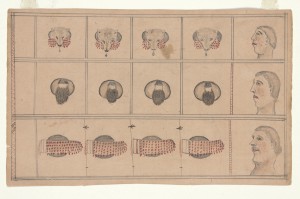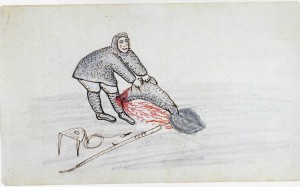Drawing A
Inventory of regalia used for the Eagle-Wolf Dance
(COO.1483.299)
Notes on Content:
Cannelle Bruschini (student):
The Wolf Dance is represented on several drawings of our collection. It is quite easy to recognize it as the dancers wear very characteristic clothes and accessories such as the aqłitiik, or pair of dancing mitts, the feather headdresses and the wolf masks. According to Johnston, the wolf is a predominant figure in Inupiaq folkore. In many tales, it carries the hostility and serves as “a compensatory outlet for repressed aggression.”(Johnston 1991, 56) Indeed, Inupiaq villages and communities have had complex and sometimes hostile relationships with one another over the centuries. The Messenger Feast is a way to suppress them during the period in which the festival was held. In the drawings in this exhibition, we see dances performed by people wearing different kinds of clothing, suggesting that they depict dance groups from different villages who have come together for the Kivgiq.
In winter, the breath of the wolf is visible in the air as it inspires and expires. Inupiaq peoples believe that this visible breath contains the spirit of the wolf. A feather is usually attached to the lower jaw of each wolf-head mask to represent the breath and the spirit of the wolf. In this drawing these feathers are represented attached to the wolf masks. The drawing is divided into three lines and fifteen cases. The first line, divided into five cases, represents four wolf-head masks, each of them depicted on a different case. On each mask, a little object is attached, pending from its jaw before it. It could be the feather described by Johnston and representing the spirit of the wolf. On the third and last line of cases, four gauntlets are depicted. The representations were probably made with pencils as the drawings are grey. Only one color was used: the red color represents noisemakers, which have been at various times made of the empty Winchester cartridge shells, pieces of ivory or puffin beaks. Johnston refers to Murdoch to explain the use of such gauntlets: they are shaken in time to the music. These accessories are made with sealskins. (Johnston 1991, 60)
The catalogue raisonné written by Graburn, Lee and Rousselot, includes photographs of several mittens. They are sometimes also decorated with feathers. On the drawing, each mitt seems to have been represented on a drum, depicted as a grey circle below it. Such drums are also present in the catalogue raisonné of Graburn, Lee and Rousselot, and are described as made of wood and skins. These instruments served to give a rhythm to the dancers. (Graburn, Lee and Rousselot, 1996, 372-3)
Notes on Form/Style:
Elizabeth Hutchinson (instructor): Within this body of work, the faces at the right of this composition stand out. Their hair is distictively light-colored and the artist has used red stippling to give the cheeks a ruddy appearance. Like the figures viewed in profile in Drawing C, these may be spectators at the feast. Might they be non-Native guests? Each face is differentiated enough to suggest that these are portraits of specific people. Further research might reveal their identities.
Regardless of the identity of the people depicted, the rendering suggests that this is the work of Keok, whose drawings incorporate rounded forms and a similar red stippling on men’s cheeks:
Keok may also be the artist behind drawing C.
on the verso:



Leave a Reply
You must be logged in to post a comment.